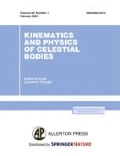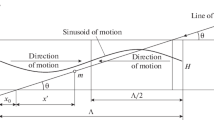Abstract
We proposed a method for diagnostics of the horizontal velocity field based on 2D observations at the center of the solar disk with high spatial and temporal resolution. The method consists in semiempirical modeling of the solar atmosphere by solving the inverse radiative transfer problem and subsequent obtaining horizontal velocities by solution of the corresponding hydrodynamic equations. We investigated the diagnostic capabilities of the line Ba II λ 455.403 nm (considering hyperfine structure and isotope splitting) for studying the horizontal velocity field of the nonhomogeneous solar atmosphere.
Similar content being viewed by others
References
L. A. Vainshtein, I. I. Sobel’man, and E. A. Yukov, Excitation of Atoms and Broadening of Spectral Lines, in Ser. Springer Series in Chemical Physics, Vol. 7 (Nauka, Moscow, 1979; Springer-Verlag, Berlin, 1981).
A. A. Samarskii, Introduction to the Theory of Difference Schemes (Nauka, Moscow, 1971).
M. I. Stodilka, “Tikhonov stabilizers in inverse problems of spectral studies,” Kinematika Fiz. Nebesnykh Tel 19, 334–343 (2003).
M. I. Stodilka, “The inverse problem for a study of solar and stellar atmosphere inhomogeneities,” Zh. Fiz. Dosl. 6, 435–442 (2002).
M. Asplund, H. G. Ludwig, A. Nordlund, and R. F. Stein, “The effects of numerical resolution on hydrodynamical surface convection simulations and spectral line formation,” Astron. Astrophys. 359, 669–681 (2000).
A. Burgess and M. J. Seaton, “A general formula for the calculation of atomic photoionization cross-sections,” Mon. Not. R. Astron. Soc. 120, 121–151 (1960).
F. Cattaneo, N. E. Hurlburt, and J. Toomre, “Supersonic convection,” Astrophys. J., Lett. 349, L63–L66 (1990).
F. Cattaneo, D. Lenz, and N. Weiss, “On the origin of the solar mesogranulation,” Astrophys. J., Lett. 563, L91–L94 (2001).
M. C. M. Cheung, M. Schüssler, and F. Moreno-Insertis, “Magnetic flux emergence in granular convection: radiative MHD simulations and observational signatures,” Astron. Astrophys. 467, 703–719 (2007).
L. Gizon, R. Cameron, J. Jackiewicz, et al., “Helioseismology at MPS,” in Modern Solar Facilities–Advanced Solar Science: Proc. Workshop Held at Göttingen, Sept. 27–29, 2006, Ed. by F. Kneer, K. G. Puschmann, and A. D. Wittmann, (Univ. Göttingen, Göttingen, 2007), pp. 89–102.
J. A. Leese, C. S. Novak, and B. B. Clark, “An automated technique for obtaining cloud motion from geosynchronous satellite data using cross correlation,” J. Appl. Meteorol. 10, 118–132 (1971).
A. Malagoli, F. Cattaneo, and N. H. Brummell, “Turbulent supersonic convection in three dimensions,” Astrophys. J., Lett. 361, L33–L36 (1990).
L. J. November and G. W. Simon, “Precise proper-motion measurement of solar granulation,” Astrophys. J. 333, 427–442 (1988).
V. L. Ol’shevskii, N. G. Shchukina, and I. E. Vasil’eva, “NLTE formation of the resonance Ba II line 455.4 nm in the solar atmosphere,” Kinematics Phys. Celestial Bodies 24, 145–158 (2008).
G. Peach, “A revised general formula for the calculation of atomic photoionization cross sections,” Mon. Not. R. Astron. Soc. 71, 13–27 (1967).
S. R. O. Ploner, S. K. Solanki, and A. S. Gadun, “Is solar mesogranulation a surface phenomenon?” Astron. Astrophys. 356, 1050–1054 (2000).
M. Rieutord, T. Roudier, H.-G. Ludwig, et al., “Are granules good tracers of solar surface velocity fields?” Astron. Astrophys. 377, L14–L17 (2001).
M. Rieutord, T. Roudier, J. M. Malherbe, and F. Rincon, “On mesogranulation, network formation and supergranulation,” Astron. Astrophys. 357, 1063–1072 (2000).
T. Roudier, F. Lignieres, M. Rieutord, et al., “Families of fragmenting granules and their relation to meso-and supergranular flow fields,” Astron. Astrophys. 409, 299–308 (2003).
N. G. Shchukina, V. L. Olshevsky, and E. V. Khomenko, “The solar Ba II 4554 Å Line as a Doppler diagnostic: NLTE analysis in 3D hydrodynamical model,” Astron. Astrophys. 506, 1393–1404 (2009).
G. W. Simon, A. M. Title, and N. O. Weiss, “Modeling mesogranules and exploders on the solar surface,” Astrophys. J. 575, 775–788 (1991).
R. F. Stein and A. Nordlund, “Simulations of solar granulation. I. General properties,” Astrophys. J. 499, 914–933 (1998).
L. H. Strous, “Feature tracking: deriving horizontal motion and more,” in Proc. 4th SOHO Workshop on Helioseismology, Pacific Grove, CA, Apr. 2–6, 1995, Ed. by B. Battrick, (ESA, Noordwijk, 1995), Vol. 2, pp. 213–217.
M. Verma, M. Steffen, and C. Denker, “Evaluating local correlation tracking using CO5BOLD simulations of solar granulation,” Astron. Astrophys. 555, A136 (2013).
N. Vitas, C. E. Fischer, A. Vögler, and C. U. Keller, “Fast horizontal flows in a quiet Sun MHD simulation and their spectroscopic signatures,” Astron. Astrophys. 532, A110 (2011).
Author information
Authors and Affiliations
Corresponding author
Additional information
Original Russian Text © M.I. Stodilka, 2016, published in Kinematika i Fizika Nebesnykh Tel, 2016, Vol. 32, No. 3, pp. 63–74.
About this article
Cite this article
Stodilka, M.I. Diagnostics of horizontal velocity field in the solar atmosphere: Line Ba II λ 455.403 nm. Kinemat. Phys. Celest. Bodies 32, 145–152 (2016). https://doi.org/10.3103/S0884591316030041
Received:
Published:
Issue Date:
DOI: https://doi.org/10.3103/S0884591316030041




